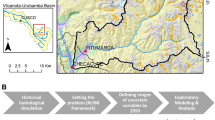Abstract
Freshwater resources in the River Thames basin in southern UK are faced with combined pressures of future population growth and climate change. River basin managers are seeking increasingly innovative methods to meet water demand whilst at the same time maintaining ecological status. Using a river network hydrochemical model modified to account for possible future climate and population, the paper assesses the impact on downstream water quality of changing the location of a major point of abstraction serving the city of Oxford. The rationale behind the hypothetical change, although entailing an increase in energy costs and capital expenditure, was that flows would be maintained along a sensitive stretch of river. Model results at a location a further 23 km downstream suggested that better water quality would arise from this change. The predicted improvements included a decrease in the annual frequency of low DO concentrations (<6 mg L−1) from 8–9 days to 2–3 days and a decrease in 90th percentile (summer) temperatures of 0.6 °C. It is believed these improvements would primarily be attributable to shortening of river residence time which curtails accelerated phytoplankton growth. The overall conclusion, of relevance both for the Thames basin and elsewhere, is that water quality in a river network can be surprisingly sensitive to the location of abstractions. Changing the location of abstractions should be considered as part of a suite of measures available to river basin managers when making plans to meet future water demand.




Similar content being viewed by others
References
Acreman MC, Ferguson AJD (2010) Environmental flows and the European Water Framework Directive. Freshw Biol 55:32–48
Bell VA, Kay AL, Cole SJ, Jones RG, Moore RJ, Reynard NS (2012) How might climate change affect river flows across the Thames Basin? An area-wide analysis using the UKCP09 Regional Climate Model ensemble. J Hydrol 442-443:89–104
Bowes MJ, Gozzard E, Johnson AC, Scarlett PM, Roberts C, Read DS, Armstrong LK, Harman SA, Wickham HD (2012) Spatial and temporal changes in chlorophyll-a concentrations in the River Thames basin, UK: are phosphorus concentrations beginning to limit phytoplankton biomass? Sci Total Environ 426:45–55
Dadson S, Hall JW, Garrick D, Sadoff C, Whittington D, Grey D (2017) Water security, risk and economic growth: insights from a dynamical systems model. Water Resour Res 53:6425–6438
Dodds WK, Jones JR, Welch EB (1998) Suggested classification of stream trophic state: distributions of temperate stream types by chlorophyll, total nitrogen and phosphorus. Water Res 32:1455–1462
Environment Agency (2016) Thames river basin district River Basin Management Plan. Part 1. https://www.gov.uk/government/uploads/system/uploads/attachment_data/file/500548/Thames_RBD_Part_1_river_basin_management_plan.pdf. Accessed 26 Feb 2018
Hutchins MG, Williams RJ, Prudhomme C, Bowes MJ, Brown HE, Waylett AJ, Loewenthal M (2016a) Projections of future deterioration in UK river quality are hampered by climatic uncertainty under extreme conditions. Hydrol Sci J 61:2818–2833
Hutchins MG, Abesser C, Prudhomme C, Elliott JA, Bloomfield JP, Mansour MM, Hitt OE (2016b) Combined impacts of future land-use and climate stressors on water resources and quality in groundwater and surface waterbodies of the upper Thames river basin, UK, Science of the Total Environment (in press)
Laize CLR, Acreman MC, Schneider C, Dunbar MJ, Houghton-Carr HA, Florke M, Hannah DM (2013) Projected flow alteration and ecological risk for pan-European rivers. River Res Appl 30:299–314
Marsh TJ, Hannaford J (2008) UK hydrometric register. Hydrological data UK series. Centre for Ecology and Hydrology, Wallingford
ONS (2017) National population projections: 2016-based statistical bulletin. Office for National Statistics, UK
Prudhomme C, Haxton T, Crooks S, Jackson C, Barkwith A, Williamson J, Kelvin J, Mackay J, Wang L, Young A, Watts G (2012) Future Flows Hydrology: an ensemble of daily river flow and monthly groundwater levels for use for climate change impact assessment across Great Britain. Eart Syst Sci Data Discuss 5:1159–1178
Thames Water (2016) Draft drought plan October 2016 Accessed at https://corporate.thameswater.co.uk/About-us/Our-strategies-and-plans/Our-drought-plan/Drought-plan-update-2017. Accessed 3 Dec 2017
UKTAG (2008) Environmental standards and conditions (Phase 1). UK technical advisory group of the water framework directive final report April 2008
Vörösmarty CJ, McIntyre PB, Gessner MO, Dudgeon D, Prusevich A, Green P, Glidden S, Bunn SE, Sullivan CA, Liermann CR, Davies PM (2010) Global threats to human water security and river biodiversity. Nature 467:555–561
Waylett AJ, Hutchins MG, Johnson AC, Bowes MJ, Loewenthal M (2013) Physico-chemical factors alone cannot simulate phytoplankton behaviour in a lowland river. J Hydrol 497:223–233
Wen Y, Schoups G, van de Giesen N (2017) Organic pollution of rivers: combined threats of urbanization, livestock farming and global climate change. Sci Rep 7:43289
Acknowledgements
We acknowledge support from NERC-CEH Pollution & Environmental Risk and Water Resources Science Areas. The model was supplied with and tested against hydrological data from the National River Flow Archive. Solar radiation data were accessed from British Atmospheric Data Centre.
Author information
Authors and Affiliations
Corresponding author
Electronic supplementary material
ESM 1
(DOCX 22 kb)
Rights and permissions
About this article
Cite this article
Hutchins, M.G., Bowes, M.J. Balancing Water Demand Needs with Protection of River Water Quality by Minimising Stream Residence Time: an Example from the Thames, UK. Water Resour Manage 32, 2561–2568 (2018). https://doi.org/10.1007/s11269-018-1946-0
Received:
Accepted:
Published:
Issue Date:
DOI: https://doi.org/10.1007/s11269-018-1946-0




